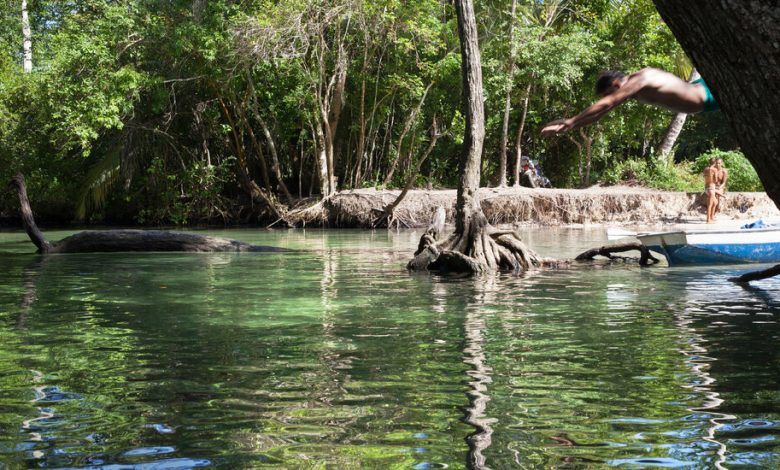Diving Into the Dominican Republic’s Springs and Rivers

The tree-ringed lagoon glowed a color you usually see only in the mouthwash aisle, and under the surface of its glassy water, fallen branches looked like open hands ready to make a catch. The boulders at the bottom were either a few feet down or impossibly deep — the clarity of the water made it impossible to tell.
Hoyo Claro, a spring-filled pool known as a cenote (say-NO-tay) in the Dominican Republic, was just a few miles inland from the luxury all-inclusive beach resorts of Punta Cana, but it felt like a different universe.
If sandy Caribbean beaches are the face of the Dominican Republic, its streams, rivers and cenotes are its veins, arteries and heart. The capital, Santo Domingo, is framed by three rivers, the Haina, the Isabela and the Ozama, upon which the conquering Spaniards built their fort, the first in the Americas, in 1496. The country, which shares the island of Hispaniola with Haiti, to the west, is laced with waterways and peppered with those irresistible neon blue cenotes.
Dominican friends balked at my plan to rent a car and visit the rivers and cenotes alone last summer. The country has a reputation for being a little rough, an idea bolstered by a U.S. Department of State advisory, which warns U.S. citizens to exercise increased caution while traveling in the Dominican Republic. And with 65 of every 100,000 Dominicans dying in road accidents every year, the country also has the highest rate of traffic fatalities in the Americas, according to World Bank data.
Instead, I joined two of those friends, Hogla Enecia Pérez and Manuel Herrera, on a journey over some rugged dirt roads that are better hiked than driven. Hogla rented a car for us to visit one river. And using a cousin’s S.U.V. with four-wheel drive, Manuel ferried me and, on one day, his family to other swimming holes. In the Dominican Republic, small, rural pools like Hoyo Claro are marked only with a small plastic sign, barely visible from the road, so finding them is a great way to sample Dominican warmth and hospitality: Invariably, you’ll have to pull over and ask directions from a local.
Once you find a swimming hole and immerse yourself in the cool, clear water, you may feel, as I did, ducking under the water, that you’re feeling the heartbeat of the Dominican Republic itself.
We are having trouble retrieving the article content.
Please enable JavaScript in your browser settings.
Thank you for your patience while we verify access. If you are in Reader mode please exit and log into your Times account, or subscribe for all of The Times.
Thank you for your patience while we verify access.
Already a subscriber? Log in.
Want all of The Times? Subscribe.




